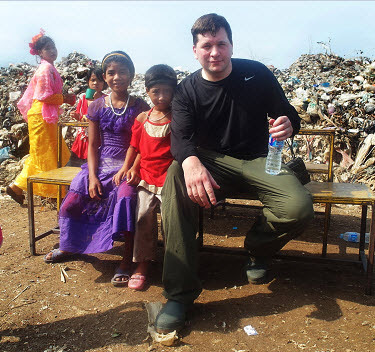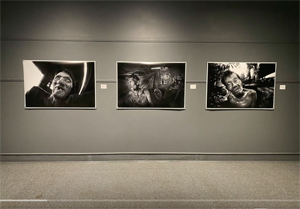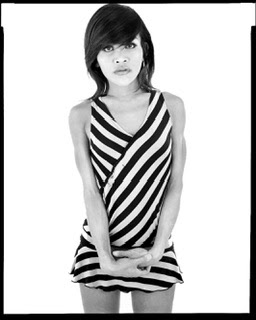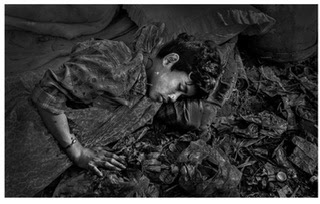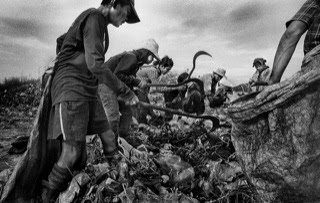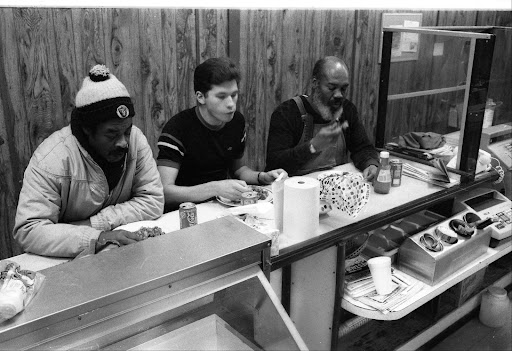By Blake Gopnik
Washington Post Staff Writer
Monday, September 15, 2008; C01
Tomorrow through Friday, a Washington Post writer will examine a particular photo from the show "Richard Avedon: Portraits of Power " at the Corcoran Gallery of Art.
Richard Avedon photographed celebrities: presidents and generals, great artists and heads of industry. And he photographed nonentities: no-name soldiers and protesters and secretaries. What makes him one of the greatest portraitists of the 20th century is that, when he's at his very best, you can't tell which is which. Forget the old idea that portraiture's about revealing what a sitter has done, or some kind of "deeper self." Avedon goes even deeper than that, down to the banal personhood that we all share. He reveals his sitters as being simply there , and real. He gives them a compelling authenticity, even if he never claims to reveal the "authentic" them.
Of course, Avedon needs all the tricks in his tool kit to simulate such unadulterated, unplanned states of being.
"Richard Avedon: Portraits of Power," which opened at the Corcoran Gallery of Art on Saturday, lets us watch the photographer achieve his no-frills portrait style. The show's 231 portraits stretch from 1950, when Avedon was 27 and just launching his career as the world's greatest fashion photographer, to shots done not long before his death in September 2004, when the 81-year-old celebrity was felled by a stroke in the middle of a New Yorker assignment.

The show's not as tight as it could be. "Power" is interpreted so widely it covers playwright Clifford Odets (the 1950 image) as well as an average couple from a gun show in Nevada (one of Avedon's last shots). It seems to include everyone who could possibly assert or be touched by authority, which means there's no one it ex cludes. A better title might have been "Portraits of People," if that weren't redundant.
The project's also risky for the Corcoran. The impoverished gallery has a long-standing reputation for pandering to ticket buyers; hosting an overstuffed survey of yet another celebrity photographer -- after last year's Ansel Adams and Annie Leibovitz events -- looks perilously close to selling out. Art lovers groaned when the Avedon show was announced. Only the hard work and scholarship of curator Paul Roth -- his catalogue essay, though more focused than the show, has 264 footnotes -- has made the risk pay off. There's an Avedon here we haven't seen much of before, and it's the one the photographer himself seemed most committed to.
I met Avedon a half-dozen or so times (he was the close friend of a sibling). When I praised the fashion photos I thought were his greatest work, he disagreed. He preferred his images of what-you-see-is-what-you-get reality.
The Avedons at the Corcoran give us the real Henry Kissinger. The authentic Andrew Young. The unadorned Ronald Reagan. The actual Duke and Duchess of Windsor. But also the authentic Abraham Rosenthal, Pete Rozelle and Evelyn Lincoln.
Who? Precisely. The crucial thing about Avedon's approach is he's an equal-opportunity authenticator. Here you are, in the presence of someone who's supposed to be the greatest recorder of the nation's great and mighty, and you can't tell the players without a scorecard.
Look at Avedon's group portrait of the Chicago Seven, famous opponents of the Vietnam War, presented larger than life on one wall of the Corcoran. (The huge, unframed photos are the exact prints that were on the wall at Avedon's landmark Marlborough Gallery show in New York in 1975.) Then turn your back on them to look at a companion image of the 11 men in the Mission Council, who led that war. You're struck not by the two groups' fundamental differences but by their underlying sameness. Strip away the beards and jeans and slouches of the protesters, and the suits and uniforms and ramrod backs of the hawks -- Avedon's portraits ask you to do such stripping -- and you're left with 18 people whose shared but flawed humanity is all that really counts. In Avedon's portraits, it's not what or who his sitters are that matters. It's that they are.

Back in 1975, this newspaper asked Avedon if he planned on photographing politicians. He said no: "There has to be a connection between me and the people I photographed. . . . I have to get the sense that we're all in the same boat." What he came to realize is that every single one of us is in that boat, and that his pictures could convey that fact.
* * *
How did he do it? Some of Avedon's "tricks" are right there on the surface. The neutral lighting and white backgrounds are his most obvious, much discussed devices: They put his portraits in the company of impartial scientific illustrations, of catalogue photographs, of ID shots -- which is where Avedon got his start in photography, taking pictures for identity cards in the merchant marine. Plain white backgrounds deny fanciness or trickery.
The preservation of his negatives' black borders (known in the trade as "rebates") is a similar device. Those borders, which became the crucial Avedon trademark, flag the fact that he is using the kind of huge, unwieldy sheet-film camera favored by the most technical of photographers. It's as though he doesn't want to risk missing a single pore in any sitter's self. Such cameras sit foursquare on the floor, often on massive stands or tripods, and they invite a notion that their subject is equally stolid. There's no interacting with such a behemoth camera; you're just a thing that's set before its eye to be recorded.
Avedon's black borders also signal that we're seeing every bit of subject that his camera did, without a drop of editing from the photographer. They are the trademark sign of a contact print, the first and most immediate encounter anyone can have with the content of a photographic negative. Avedon's borders assert the edge-to-edge authenticity of a photograph -- of his whole photographic technique. And that's supposed to rub off on his sitters.

Then there's where those black edges fall. In many of Avedon's portraits, they slice right through a figure or a body part. In his "Chicago Seven," all shoes are awkwardly cut off in mid-foot. In "The Family," Avedon's photo essay on this nation's Bicentennial elite -- its 69 images originally filled 48 pages of the Oct. 21, 1976, issue of Rolling Stone -- many of the mighty have their hands, the most expressive of body parts, cropped off at the wrist. For about 500 years, artists have used that kind of "accidental" cropping by the picture's edge as a sign of spontaneity -- as the sign of a scene not planned to look just so but captured on the fly, as it happens to pass into or out of the artist's field of view. There's authenticity for you.
The whole setup recalls a zoologist's camera blind, put out in the wild and then removed from human control. Avedon's best portraits present him as a machine for seeing. "I just popped in and did it and left," is how Donald Rumsfeld remembers his session for the "Family" series, and that squares with other people's memories. "All of the photos were rather matter-of-fact -- minimal instructions and minimal posing by him. Just look in the camera and click," recalled Julian Bond, chairman of the NAACP.
Those are some of the markers of the "truth" that are right there for the looking in each Avedon portrait. But there are others that operate less openly.
You may not grasp it consciously, for example, but your eye knows that many of these portraits were taken from closer in than usual. Look hard at Avedon's 2004 portrait of a yet-to-be-famous Illinois state senator, Barack Obama, and you realize that his nose is rather larger than his ears. That gap in scale is something we only see when we're up close to someone. Without resorting to forced, rhetorical signs of intimacy -- a deliberate smile, a welcoming gesture -- Avedon can make a remote politician into someone you can get close to.
Or look at how Avedon can make Buckminster Fuller, with an ego's worth of plans for reshaping the Earth, look like the old man next door you want to buttonhole -- that you have buttonholed, since you're so close you see the tops of his shoes and the underside of his chin at the same time. That means that you're not only close, you're also looking at him from nearer to his navel than his head, another device Avedon uses to stress his portraits' neutral, scientific gaze. They forgo the eye-to-eye encounter that can make a sitter seem unique and engaging -- and too special to be just another one of us.
Anthony Van Dyck, the great pioneer of royal portraiture, perfected perspectival tricks to make his noble sitters look unusually tall. Avedon used the special capabilities of a large-format camera -- lens tilts and film shifts and other esoterica -- to reverse precisely those same tricks. He crafted a democratic vision that brings his modern royals down to earth. Fuller's legs don't seem to soar above us like the legs of a Van Dyck cavalier; they seem strangely compressed, as though we're looking down at them. Ditto for the legs in Avedon's Chicago Seven, or in his image of the Joint Chiefs of Staff in 1976, or in almost any of his full-length portraits of achievers.
Writers and wall texts have claimed that the great portraits of Richard Avedon, our greatest portraitist, uniquely reflect the "zeitgeists" he lived through, or his sitters' special "essences." Look closely at Avedon's portraits and you realize that, when they are most uniquely his, they work against those cliches. They give a sense that whatever pose his sitters may be taking, whatever character they may assume, Avedon has captured an averageness that matters more.
In Avedon's hands, Mark Felt gets to be the-guy-who's-just-Mark-Felt. There's no revealing the Deep Throat within.









